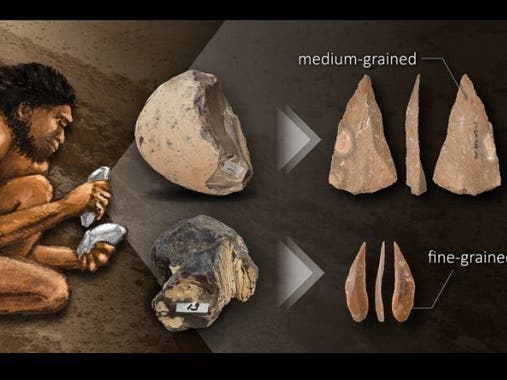Paleolithic Humans May Have Understood The Properties Of Rocks For Making Stone Tools
Snippet “ The research team led by the Nagoya University Museum and Graduate School of Environmental Studies in Japan believe Paleolithic humans understood which rocks were appropriate for making tools and, therefore, intentionally searched for them. According to their hypothesis, Paleolithic humans intentionally searched for flint that was translucent and smooth, as it could be easily broken off the rock face and shaped into sharp edges.
The group used a Schmidt Hammer and a Rockwell Hardness Device to test the mechanical properties of the rocks. The Schmidt Hammer measures the elastic behavior of a material after the hammer strikes it, which tells researchers its rebound hardness. The Rockwell hardness device presses a diamond indenter on the rock surface to test its strength.
At first, as Suga and Kadowaki expected, fine-grained flint was found to require less force to fracture than medium-grained flint. This would have made the fine-grained flint more attractive in producing small stone tools. Indeed, many stone tools from the Early Upper Paleolithic (40,000 to 30,000 years ago) contain fine-grained flint.
However, an earlier study by the same team found that during the Late Middle Paleolithic and the Initial Upper Paleolithic (70,000 to 40,000 years ago), medium-grained flint was more commonly used in stone tools than fine-grained flint. But if fine-grained flint was so easy to use, why did our ancestors not make all their tools from it?
On further investigation, the researchers found that much of the fine-grained flint in the area suffered from abundant internal fractures caused by geological activities, which would have made it unsuitable for large stone tools, such as Levallois products and robust blades. Therefore, it seems that Paleolithic humans selected the medium-grained flint for large tools, even though it was a tough material to modify into tools, as it was more likely to last longer.
This offers a fascinating insight into our ancestors' behavior, as they selected flint based on many factors other than just how easy it was to fracture and could discern the most suitable rock to use to make stone tools.
Suga is enthusiastic about the findings, which suggest the complexity of our ancestors' behavior. "This study illustrates that the Paleolithic humans changed their choice of raw material to suit their stone tool morphologies and production techniques," he said.”
Journal article: https://doi.org/10.1007/s41982-023-00164-w



Add comment